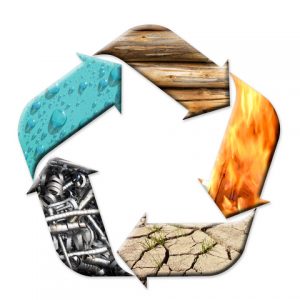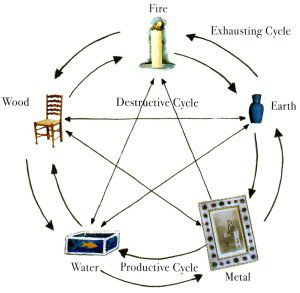The Five Elements of Feng Shui
Feng Shui, a traditional Chinese practice, revolves around the concept of the five elements: wood, fire, earth, metal, and water. Each element is believed to represent a different aspect of life and plays a crucial role in creating balance and harmony in your environment. Wood signifies growth and vitality; Fire represents passion and energy; Earth symbolizes stability and nourishment; Metal embodies strength and clarity; while Water represents fluidity and adaptability. By incorporating these elements into our living spaces through colour choices, materials, shapes, and patterns, we can create a harmonious flow of energy that promotes health, prosperity, and overall wellbeing. Whether you’re rearranging your furniture or decorating your home, keeping the five elements in mind can help improve the energy flow in your space and enhance your quality of life. However in order to take advantage of the positive energy you must also eliminate any negative energy that might be creating a disturbance in the flow.
The Relationship Between The Elements
In Feng Shui, the five elements – wood, fire, earth, metal, and water – are believed to interact with each other in specific ways to create harmony and balance in a space. Wood feeds fire, fire creates earth (ashes), earth produces metal (minerals), metal carries water (condensation), and water nourishes wood. This cyclical relationship is known as the “productive cycle” where each element supports and enhances the next in a continuous flow of energy. Additionally, there is a “destructive cycle” where elements can clash or negate each other’s energies if they are in direct opposition. Understanding how these elements interact can help you design your space for optimal energy flow and alignment with your intentions and goals. It’s all about finding that delicate balance between the elements to create a harmonious environment that supports your wellbeing and success.
Water
Water represents travel, abundance, learning and communication. In order to create balance in your space, it’s important to incorporate water elements like fountains, aquariums or mirrors that reflect water images. The balancing element for water is metal, which can be added through metallic décor accents or colours like silver and grey. On the other hand, the conflicting element for water is fire, so it’s best to avoid using red or orange tones too close to water features. To use water effectively in Feng Shui practices, try placing a small fountain in the North area of your home for career success or in the South East corner for wealth luck. Just remember to keep the water clean and flowing to ensure positive energy throughout your space.
Wood
Wood represents the Feng Shui Five Elements with its connotations of growth, creativity, ethics, generosity and expansion. To balance the wood element in your space, incorporate wooden furniture, plants or green accents to promote a sense of vitality and health. The metal element is considered the balancing force for wood, as it helps to temper its excessive growth and encourages a harmonious relationship between the two elements. On the other hand, the conflicting element for wood is fire, which can create tension and conflict within a space if not properly managed. To minimize this conflict, you can introduce elements of water or earth to help cool down the fiery energy brought forth by fire. Overall, embracing the wood element in your home or office can bring about a sense of renewal and rejuvenation to your environment.
Metal
Metal symbolizes precision, clarity, and efficiency. It is associated with the colours white and grey, as well as circular shapes and metallic objects. To balance the metal element in your space, you can incorporate round or oval decorative items, such as mirrors or clocks. The earth element serves as a balancing force for metal, so adding earthy tones like brown or terracotta can help create harmony. On the other hand, the conflicting element for metal is fire; to avoid clashes, it’s best to limit red or fiery hues in a predominantly metal-themed area. The Feng Shui element metal has the ability to conduct as well as transmit energy thus believers in Feng Shui typically include metal objects in their environment. Some people believe that metals can be beneficial for health just by wearing them. Metal also represents money and success; however it also has a destructive quality. Harnessing the power of metal in Feng Shui involves embracing minimalism and sophistication while staying mindful of its interactions with other elements.
Earth
Earth represents stability, nourishment, permanence and protection. To balance the earth element in a space, you can incorporate shades of yellow or brown colours, square shapes, and items made of clay or ceramic. The balancing element for Earth is fire, which symbolizes passion and transformation. Adding red or orange accents, triangular shapes and candles can help enhance the Earth energy. On the other hand, the conflicting element for Earth is water, representing flow and emotions. To minimize this conflict, limit the use of black or dark blue colours and avoid putting water-related objects like fountains or mirrors in an earth-dominated area. By understanding how to harmonize these elements within your space using colours, shapes, and materials accordingly can create a more balanced and positive environment for yourself.
Fire
Fire represents passion and energy and followers of Feng Shui consider fire to be the most powerful of all the Feng Shui elements. It represents passion, creativity and transformation. It is often associated with the South direction and the colour red. To balance the fire element in your space, you can add objects like candles, lighting fixtures, or vibrant artwork to enhance energy flow and vitality. However, be cautious of overwhelming your space with too much Fire energy as it can lead to feelings of aggression or restlessness. To counteract this, incorporate the Water element in the form of mirrors, fountains or shades of blue to create a harmonious balance. Remember that Fire and Water are conflicting elements in Feng Shui; therefore, it’s essential to find a delicate equilibrium between the two for optimal energy flow and wellbeing in your environment.
UPDATED: May 3rd, 2024.


